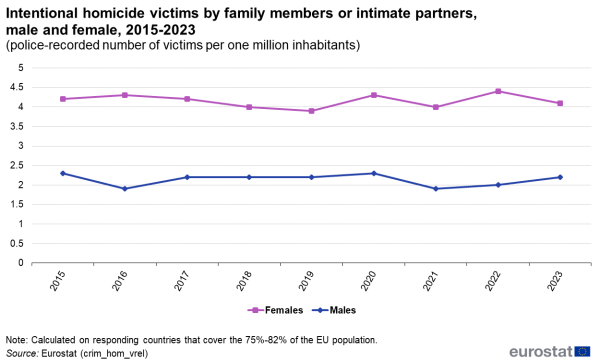Data extracted in April 2025
Planned article update: April 2026
Highlights
In 2023, sexual violence offences, including rape, continued to rise in the EU.

The statistics presented in this article are based on official figures for police-recorded offences (criminal acts) in Europe between 2008 and 2023. The number of police-recorded crimes varies widely across the EU, even relative to population size. This can be due to different laws, different police recording practices and different reporting rates to the police, which can affect comparison.
3 930 intentional homicides in the EU in 2023
In 2023, police recorded 3 930 intentional homicides in the EU, compared with the previous year, an increase of 1.5% (Figure 1). An increase was observed in 11 of the 27 EU countries, with the biggest upward changes in absolute numbers occurring in Germany and France.
Number of women killed by family members is nearly double than for men
The number of female victims of intentional homicide killed by family members or intimate partners in 2023 was 4.1 per one million women, nearly double the rate for male victims, 2.2 per million men.
Women are more frequently victims of intentional homicide by family members or intimate partners – the EU rate per one million women fluctuated between 3.9 and 4.4 from 2015 to 2023, peaking in 2022 (Figure 2). In 2023, the rate decreased to 4.1.
By contrast the EU rate of intentional homicide male victims killed by family members or intimate partners remained notably lower than those for women. Over the same period, it ranged from 1.9 to 2.3 per one million men with the lowest values in 2016 and 2021. In 2023, the rate increased from 2.0 in 2022 to 2.2 male victims per one million men.
These figures highlight the persistent gender disparity in domestic and intimate partner homicides across the EU.

Source: Eurostat (crim_hom_vrel)
The number of sexual violence offences increased during 2013-2023
From 2013 to 2023 the number of sexual violence offences, including rape, as recorded by police in the EU, has shown a steady increase, reaching a 79.2% increase in 2023 as compared with 2013. The number of rape offences, as a part of sexual violence offences, more than doubled during this period (a 141% increase) (Figure 3). In 2023, 243 715 sexual violence offences (including 91 370 rape offences) were registered, showing a 5.5% increase (including a 7% increase in rape) compared with 2022.
The increased number of police-recorded sexual violence offences are closely connected to raising awareness in the society and might impact reporting rates.
During the pandemic (2020-2021), police-recorded theft offences in the EU had their lowest dip in 2021 – a decrease of 19.2% compared with 2019 (Figure 4). In 2023, there were 5 387 857 registered thefts, a 23.5% increase compared with 2021, and a 4.8% increase compared with 2022.
In 2023, the number of police-registered burglary offences was 1 229 429. After a steady decrease from 2010 to 2021, the number of police-recorded burglary offences showed an 11.9% increase compared with 2021 and a 4.2% increase compared with 2022.
Robbery is less prevalent, however, the most serious property related crime of the 3. In 2023, in the EU, the number of police-recorded robbery offences was 261 361, an increase of 13.2% compared with 2021 and a 2.7% increase compared with 2022.
Corruption offences slightly increased in 2023
In 2023, there were 72 408 corruption offences as registered by police, including 12 963 bribery offences, which was a respective 4.4 % and 6.6 % increase compared with 2022 (Figure 5). The number of corruption offences peaked in 2018, when it reached 77 681. The highest number (19 855) of bribery offences was registered in 2021.
Source data for tables and graphs
Data sources
Statistics on crime and criminal justice systems in general
Data sources include police and other law enforcement agencies, public prosecutors, law courts, prisons, relevant ministries, and statistical offices. The national authorities are responsible for official figures that are sent to Eurostat and to the United Nations (UN Survey on Crime Trends and Operations of Criminal Justice Systems). The crimes are classified according to the ICCS (International Classification of Crime for Statistical Purposes). Counting methodologies for offences and persons should be applied. Countries' compliance with the classification of crimes and counting methodologies is explained in the crime metadata.
The data of this article
This article presents results based on official figures for police-recorded offences (criminal acts) from 2008 onwards. The web database contains figures as reported (no adjustment).
Particular crimes
Additional data on intentional homicide, rape, and sexual assault:
Earlier data
Context
Crime statistics are used by EU institutions, national authorities, media, politicians, organisations, and the general public. Each state establishes its criminal laws, define crimes, legal proceedings and justice reactions, as well as specifications for official crime statistics (except for crimes that are covered by international or EU law). Typically, comparing crime statistics between countries is challenging due to different national criminal laws and different criminal justice systems.
However, it could also be argued that there are many similarities between European countries. This, combined with public and political interest, was the background for developing EU-wide crime statistics. Over the last decade, EU institutions, national authorities, and the UN have cooperated to improve European crime statistics. A major quality improvement is to use a common classification of crimes.
Official crime statistics mainly reflect how the authorities register and handle cases. The figures are provided by national authorities such as the police, prosecution, courts, and prisons. Of those, police figures give the broadest picture, as they include recorded offences, whether or not they led to prosecution. Still, the police records do not measure the total occurrence of crime. Simply put, the total occurrence would be the reported plus the unreported, minus the incorrectly reported. It is fair to assume that the reporting rate is high when a police record is required to support an insurance claim (e.g. car theft and burglary).




